When you think of potted meat you probably think of Armor. Ritz cracks and that weird gelatin on top might come to mind, too. If you are like me, you think of great memories on the couch with dad. We would eat this stuff together and watch TV.
You might also think of your own pantry. You know, these canned meats have a tremendous shelf life and make for a great protein solution. Did you know that canned meats can last up to 5 years beyond the best by date printed on the can?
While you might think that potted meat came to be during the age of metal canning and the industrial revolution, you would be mistaken. Just because it’s in a tin can today does not mean it started that way. The potting of meat or preserving meat by covering it in its own fat is hundreds of years old.
It was a process so popular, in fact, it was published in more than one volume on cooking in the 1700s. We are going to be using a recipe from the 1778 book A Lady’s Assistant By Charlotte Mason. The recipe is called Potting Beef.
I like this recipe best because it’s very easy, it doesn’t require any added nitrites and it can be executed with everything the average person has on hand. We are going use a modern-day twist on the “POTS” used but other than that it will be pretty much the same method used in the 1700s.
The Power of the Fat Cap
Before we get to the process of potting meat I would like to talk about the preserving power of fat. When it hardens fat creates a barrier from moisture and oxygen.
Most bacteria need moisture and oxygen to survive. Without those two things, bacteria will not be able to proliferate. That fat cap on potted meat is what preserves it. That barrier is vital. It’s very similar to the process of the French confit which preserved duck legs under duck fat.
The ideal place to store your potted meat will be in a cold place where the fat cap can harden. That is assuming the power is out. Of course, a fridge will be the best option. The French even buried their duck confit in earthenware to assure that fat cap did not get compromised. If you want a great place to keep your survival items, including your food, safe, the Easy Cellar is a great an accessible option.
Tools
The “pots” that would have been used were little more than earthenware or ceramic cups. Before the tin can this was how meat was potted. Our modern twist on this recipe is the resourceful use of coffee cups as the pots. I figure we all have a few too many coffee cups.
- A Few Coffee Cups
- A Large Bowl
- A Sauce Pot
- A Muddler or Another Tool to Pulverize the Beef
Ingredients for Potted Meat
- A Few Pounds of Beef
- Good Whole Butter
- Clarified Butter
Related: Making Butter at Home, Like Our Grandparents
The Process of Making Potted Meat
Potting beef is very simple. Let’s start with that. We are simply going to mash up the meat and beat in some more fat. Then we are going to cover the entire thing with even more fat.
#1. Slow cook your beef, however, you are comfortable until it is falling apart. You can use a Dutch oven for this if you don’t know what you’re doing.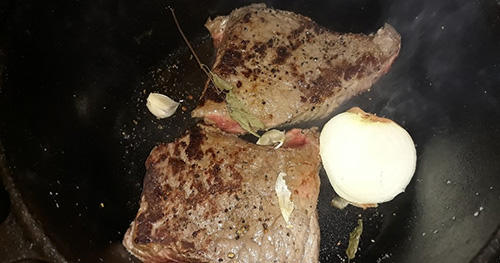 Once the meat is tender you are going to want to shred it a bit and chill it.
Once the meat is tender you are going to want to shred it a bit and chill it.
#2. After 8 or so hours your meat should be completely chilled, and you can start the process. Place all the meat into the bowl and begin to mash it with your muddler or something else hard that will really macerate the meat.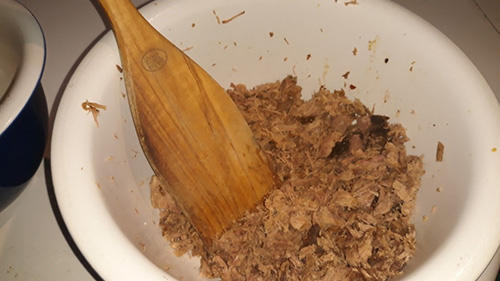 I guess you could use a food processor for this step but if you are making this recipe from the 18th century it seems kinda weird.
I guess you could use a food processor for this step but if you are making this recipe from the 18th century it seems kinda weird.
#3. Now you are going to add an extra third the amount of butter to your meat and continue mixing this. You really want to incorporate the butter.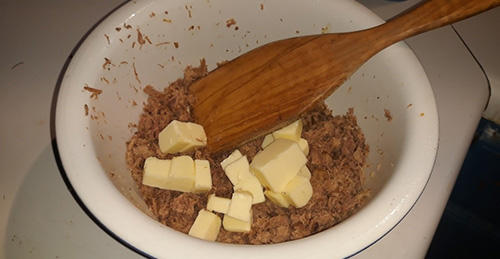 Understanding the idea behind an extra third is very important because it gives you the ability to reproduce this recipe no matter how much beef you have.
Understanding the idea behind an extra third is very important because it gives you the ability to reproduce this recipe no matter how much beef you have.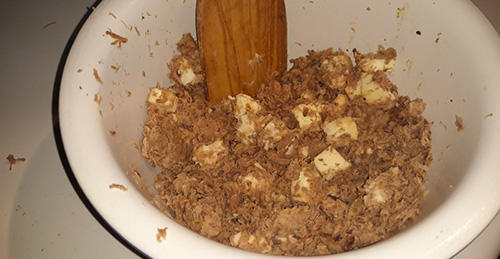 For 2lbs of cooked beef, we will simply use another pound of butter. If you were doing 20lbs of beef you would apply a third of the fat and that would be 10lbs. This ratio makes this process very simple to scale.
For 2lbs of cooked beef, we will simply use another pound of butter. If you were doing 20lbs of beef you would apply a third of the fat and that would be 10lbs. This ratio makes this process very simple to scale.
#4. Now you are going to press your butter meat mixture into your “pots” and leave about 2 inches from the top. This will assure you have room to pour your butter.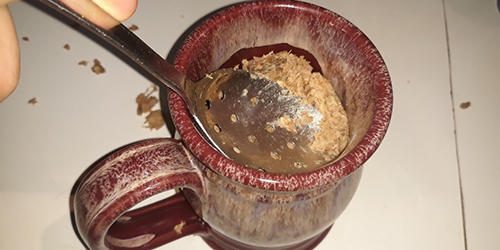 #5. Place your pots on a sheet pan and warm them around 200 degrees just until they are warmed through. This will take about a half-hour.
#5. Place your pots on a sheet pan and warm them around 200 degrees just until they are warmed through. This will take about a half-hour.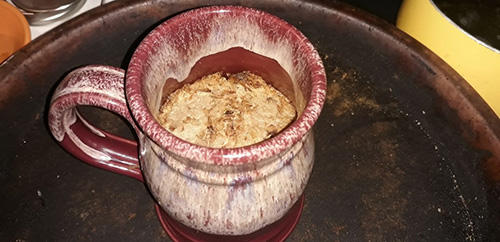 #6. In your saucepot melt the clarified butter. When you pull the pots from the oven you can start ladling some warm clarified butter into the open space in your pots. Fill them up good. This seal does all the preserving.
#6. In your saucepot melt the clarified butter. When you pull the pots from the oven you can start ladling some warm clarified butter into the open space in your pots. Fill them up good. This seal does all the preserving.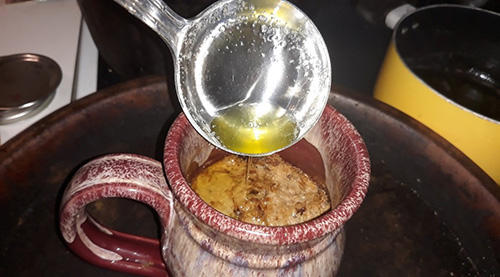 I used about ½ cup of melted clarified butter.
I used about ½ cup of melted clarified butter.
#7. Now chill the pots completely and you have potted your first bit of beef.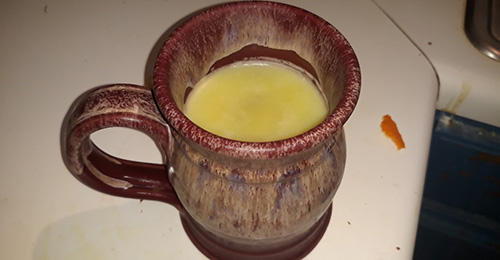 If you can keep the clarified butter intact you will be able to store these pots for months at a time, even 6 months. This requires storage in a cold, undisturbed environment. There may be no better way to preserve your meat in the winter. These pots can be stored covered outside in an off-grid situation. You might even be able to get away with storing them in a root cellar.
If you can keep the clarified butter intact you will be able to store these pots for months at a time, even 6 months. This requires storage in a cold, undisturbed environment. There may be no better way to preserve your meat in the winter. These pots can be stored covered outside in an off-grid situation. You might even be able to get away with storing them in a root cellar.
Potted meat has come a long way since the 1700s. When you make this potted beef, you will see just how different and how delicious home potted meat can be. It’s much more than a cheap amalgamation of pork parts and chicken parts that are canned under pressure.
You might also add herbs to this potted meat recipe. Things like oregano and thyme are not only going to flavor your meat but they are also going to add some medicinal properties to your recipe.
There is no denying it, cooking from scratch is true salvation and one of the most important survival skills.
If you’re interested in crisis-ready food, I’ve got a great tip for you: cheap, simple, and easy to put into practice. Here’s how to stockpile 272 pounds of long-lasting survival food for just $5!
You may also like:
7 Primitive Cooking Methods You Still Need to Know Today
Cheap and Easy to Build Root Cellar in Your Own Back Yard (Video)
How To Can Potatoes for Long Term Preservation

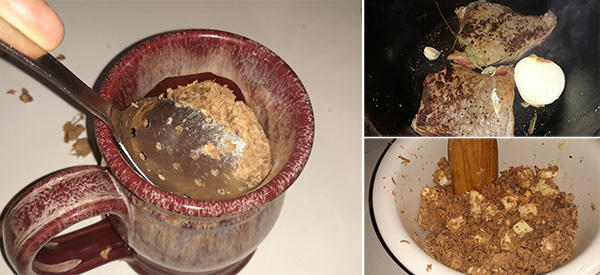















My great grandfather was a third generation Scots pig farmer in Southern Illinois. He made potted meat from pig and chicken left overs. It was cooked in a scary-looking black caldron in the smoke house. He seasoned it with all sorts of dried herbs, salt and pepper. When the meat was the consistency of heavy sludge it was poured into quart-size crocks, covered tightly with cheese cloth and cooled in the cellar. The fat from the assorted meats would congeal and harden forming an air tight seal. In the winter months, a crock was brought into the kitchen, and dumped out onto the cutting board. The fat was melted in a large cast iron skillet, and the meat was cut into thick, round slabs, dusted with corn meal and friend in the fat. Pure protein and saturated fat. Sounds awful? Gosh, my great grandfather lived to be 92 and died peacefully in his sleep, so I guess the potted meat had served him well.
One third= 10.6 ounces. Not one pound. Though im sure it tastes wonderful.
You are correct based on how it was being said, though based on the examples…2lbs meat to 1lb butter and 20-10, it sounds like the author was meaning 2/3 meat to 1/3 butter, by weight, although the verbiage is off in the description. And then additional clarified butter to cap it off. Maybe the author will make a clarification.
I wish that the links to “interesting” articles did not all lead to plugs for “The Lost Ways”. That book is a waste for those of us who own the Foxfire series. It is also a crooked way to hawk the book.
Farmer,
I agree that the Foxfire books are an excellent resource; but, as for the links being a crooked way to hawk the book, perhaps it’s also how funds are raised to maintain this website, unless you’ve made a personal donation to keep it running.
Tolerating links to an ad is a small price to pay for access to this free site.
Yes the Foxfire are good resources, however taking 15 volumes into the field with you to practice basic survival would call for a Samsonite to haul all of those around, The Lost Ways has everything you need for the field, it’s like a practical indoor outdoor book, I can literally roll it up and stuff it in my BOB and be on my way, I own both and would much rather have The Lost Ways on hand.
I’m guessing the use of butter probably adds tremendously to the taste, but can lard or beef fat also be used, if you happen to have that on hand?
Rhonda, I would go with beef suet. It has a wonderful flavour and it hardens up way better than butter or muscle fat.
TheSouthernNationalist,
Beef suet would be a good choice; but, so would bacon grease. Any fat to seal out the oxygen in the air should work.
I guess you could use bacon grease, I only suggested suet since it does harden quite nicely whereas bacon grease still stays greasy
Yeah, but anything smoked attracts rodents. For me, beef tallow is the best. niio
I agree, also beef tallow does not require refrigeration to be stored for extended periods at a time, to where as suet will have a chance of going rancid if not stored below 68 I believe.
Can you use other meats like rabbit instead of beef?
It would be much easier to explain the percentage of butter to meat as 1/2 instead of 1/3. If you have 2 lbs. of meat and need to add 1 lb. of butter, that’s half the amount of beef. Yes, you end up with 1/3 butter and 2/3 meat, but that’s not the same as saying to add 1/3 butter.
Ms.Bee-Tree, My guess is you could use any type of meat.
Once sealed it should be good for a while.
My dad used to use rabbit with great success
Would it be possible to use cleaned bacon drippings for the top seal?
Bill, bacon grease might work but it will never harden up.
On my mom’s homestead, they would make and fry sausage from a quarter of a pig. The fried patties would be layered in a stoneware crock and covered with the sausage grease. Between the grease and salt/nitrate load there was no problem with spoilage. the sausage grease was also used for gravies and even to spread on bread. Nothing was wasted. Not quite potted meat, but similar. Mom is 98, apparently the food agreed with her.
My dad, raised during the depression on a small farm, told me my grandma would fry up a bunch of meatballs and “sink ‘em all down in a crock of grease” to preserve them.
I would say any meat or fat could be used for potted meat.
Just to have to try a small amount & see. I was thinking Lard for beef, or beef Tallow.
This is good eating. When the feds were restocking supplies, they had the give-away of canned meat and salted cheese. It was mostly pork, but made gravy over toast, and so on.
In Arizona, some people still dry age halves of carcases. The sides are hung in a shaded, airy place and wrapped with an old sheet. It tied or sewn so no insects can get at it. give it a week or two, and the meat is tender, but covered with a hard, dried layer. That’s removed and the meat cut as needed. If not used, eventually, the side will dry out, not decay.
Just in case, keep rosemary on hand. One level teaspoon in a cup of boiling water, steep ten minutes and sip. One cup takes away any sign of food poisoning. No more than 2!. I’ve never had to use it when cook for a hunting camp or any cow camp. But when cooking in restaurants, it’s a very common spice. niio
One needs to keep in mind that historically, potted meat products could and did contain botulism toxin and killed people as did early sausages.
Modern canned potted meat products, are also pressure canned to kill any Clostridium Botulinum spores in them, so while this method has historical roots and may often be safe, there is a chance that the low acid and low oxygen atmosphere in the product, could grows spores and produce botulism.
add nitrate (AKA) salt peter
I apologize for the confusion with the amounts of meat to butter. I can see how talking about 1/3 after the addition is very confusing
It is 1/2 the amount of butter compared to meat. The ratio is 2:1 Meat to Fat and you could certainly use any fat that hardens to protect the meat. I love the idea of some beef fat. Beef fat also makes a great fat cap!
I have been writing here for a while and I want to thank you all for your support and readership. I am consistently overwhelmed by the knowledge that comes from this group.
What is clarified butter?
I didn’t know how to make clarified butter either, so I went on line to find out. There are dozens of methods of making clarified butter. It is easy. I suggest checking it out and printing out a method you like best. Basically it is butter that had been slowly heated. They use it in India and it is called ghee. It doesn’t go bad in the heat which is a good thing in India.
basically you heat and then drain off the fat of the butter and use the solids in something else… example when I can butter I have 2 choices as it cools… leave it on the counter and the solids settle to the bottom which changes the taste. OR as it cools, shake it up to keep the milk solids suspended in the fat….
If you like the taste of old-fashioned butter, the farm churned butter, soften, not melt, the butter and add a tablespoon of plain yogurt, mix well, and sit in the back of the fridge for a few days. The butter should stay soft enough to spread, and tastes like we made on the farm, not like grease. For that matter, when Mom had an order for a lot of butter, the milk went into the creamer, and the cream right to the churn with yogurt. Age it overnight, and then churn. niio
I know this is an older post/thread, and I hope that everyone that posted here will see this, but I wanted to put in my $0.02.
Clarified Butter and Ghee are not quite the same. Clarified butter is melted until the milk fat is separated. With ghee, the milk fats are “caramelized” (for a lack of a better term) and separated, completely. It is a lot longer, more arduous process. It also need no refrigeration. It is my understanding, that clarified butter, unless “canned” still requires refrigeration and can go rancid, ghee will not.
Roscoelong,
Clarified butter also called ghee or drawn butter contains only the butter fat with no milk solids.
You can make your own by melting unsalted butter in a double boiler and skimming off the non oily residue that floats to the surface.
If you’ve eaten seafood like shrimp or lobster and had that little container of melted butter for dipping, you’ve had clarified butter.
Basics, melt butter in a pan. You’ll find buttermilk in the butter. Separate them, save the butter, which is clear till it chills. Save it in widemouth pint or quart jars. In India, it’s called ghee, and usually made from buffalo milk. in regular butter, the milk can get moldy. Ghee should last for months, if not years. niio
Red,
What floats to the top is not buttermilk; but, only the milk solids.
Buttermilk is what is left over when churning or shaking cream into butter.
Done this many times; but, I recommend using a double boiler to do the work so you don’t scorch the butter or create a fire hazard.
It’s also called Ghee here; but, also drawn butter, into which we dip lobster or shrimp. Covered it will keep for a long time and nearly forever when refrigerated.
Tastes like buttermilk, because it comes from the buttermilk. Never had a fire when doing this. I have a jar of it bought in Brooklyn when I was last there a few years ago, and it’s on the shelf and still good. The stepdaughter only uses ghee. On occasion I use some. Ghee has to last in hot weather where no one has refrigeration. One way to make it is to use yogurt in the whole milk and in a day or so, skim the cream (yogurt made at room temp will taste a little sweet), then make butter and let that age a few days, then make ghee. I tried it and it’s great. If using soured yogurt (made at high heat in a yogurt maker), it added enough acid to preserve the ghee longer. Sweet yogurt is made like they do in India, seeth the milk. When it cools, add the yogurt, cover, and put up on a high shelf for 3 days. If sour is needed, allow it to go a few days longer. That’s how farm wives in India do it. niio
Those of us on the left coast who eat fresh artichoke, when not dipping the leaves in mayonnaise, dip them in ghee as we do with lobster or shrimp.
I usually serve fresh artichoke to out of country guests or guests from the other coast — I won’t call it the right coast because it most definitely is not that — because apparently eating fresh artichoke is a left coast phenomenon. Not a significant amount of food value if you take away the mayonnaise and ghee, but tons of fiber.
This Texas boy has been known to fix fresh artichoke, stuffed, as did my wife originally from Queens, NY, so I can’t agree that it’s a left coast phenomenon. My son prefers them not stuffed with bread crumbs and parmesan, but plain. Melted butter with garlic is what we use…hadn’t heard of using mayo. Might try mustard since that’s what we put on our burgers in Texas 🙂
red, thanks for the statement that the milk in regular butter can get moldy. i bought a brick from a large warehouse chain, and no matter what i did with it, from frying mushrooms to making toast, it always seemed to have a musty/moldy taste. i thought i was imagining things. i left half the brick in the fridge and began another with no funny taste so now i know. the spoiled one is going in the garbage. i thought butter only went rancid–which is a whole nother taste, and i keep mine in the fridge not on the counter or in the cabinet. thanks for the info and i learned something new today.
This is correct, but not too clear on how to separate the two. put about 2 pounds of butter if you can afford it in a heavy pot. turn on LOW heat for several hours. if you use a lid, leave a way for the steam to escape. you’re trying to both: evaporate off the water and separate the milk solids. L eave it on low heat and the milk solids will eventually sink to the bottom of the pan and kinda scorch there. Use LOW heat. There might rise to the top a ‘scum’ of milk solids, just skimit off the top with a screen tool. When the butter turns golden light brown, it’s done. pour the finished ghee into a jar with a tight lid. You might have to pour it through a strainer so no solids go with it.
I tried buying this, but when it came to filling out the country, only those in the usa can buy apparently. I live in Canada and i could not complete the purchase. Please tell me what to do. Can I order this by phone?
Hi Johanna,
Thank you so much for your interest in my work.
Please check your Inbox. I have just sent you an email on how to purchase the book if you live in Canada.
God bless,
Claude
Claude thank you for this article. As always very interesting and well explained. I have a question: Can I use ground beef? In the end you mash the heck out of it.
It sounds good, but as I was raised by stockmen (livestock), I won’t eat meat raw. How does it taste fried? niio
Red,
I grew up eating raw hamburger sandwiches and still eat them with mustard and a slice of onion.
We have stew beef in the freezer that we thaw out and grind into hamburger (ground beef), I eat it raw within 2 days while it’s still fresh.
No one should do this with store purchased ground beef, since the way it is manufactured, handled, and shipped can be questionable unless thoroughly cooked.
Isn’t that called beef tartare?
Yeah, what we didn’t freeze or salt, we made into sausage; German bologna and hotdogs, corned beef and pastrami, and smoked most of it. Most of our beeves and hogs were sold under the table, so to speak. I used to eat raw hamburger, but was raised around biologists, also farm-raised, who gag at the idea of raw meat. When he worked for a slaughterhouse, Dad had a friend who was a blood drinker. The man died of trichinosis because all animals will eat other animal’s manure. Canada did a study years ago, long before mad cow, to see why they were having a rabies problem with cattle. 80+% of skunks tested carried rabies and most did not show it. Since mad cow is supposed to be endemic along all states bordering Canada. Call me picky, I won’t eat game meat from those states. This is on recommendation of medical personnel in the family, who saw enough people with diseases passed on by raw meat. One cousin, a doctor of forensics, can describe in detail all about it. Nor will I from here, where rabies is always around.
Thank you all for your valuable information. I am English but now live in NZ. Ages ago I found the recipe in an old book that I had but can’t find it again. As we are now in sad times with this virus I live as much off the garden and home made stuff as I can, keeping out of the shops as much as possible.
Here I manage to keep a couple of sheep and so have an abundance of lamb in the freezer and am going to try that potted with rosemary or mint, covered with clarified butter. Keep safe all of you.
What about people in the south? we don’t stay cold that long. so how can we put up meat, to last? no place cool enough for the butter to stay hard.
Some of the old 18th century cookbooks don’t call for the potted meat to be in a cool place or the ghee (clarified butter) to be hard for it to work. With the butter in liquid form, it made it easier to take some out since the liquid would simple fill back over the meat and seal it back up.